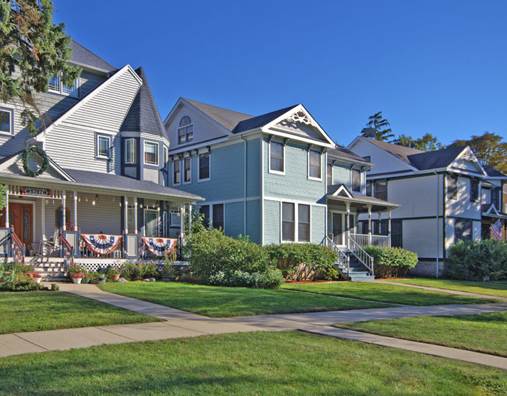Landmarks Illinois’ statement in support of City’s sound insulation program in Norwood Park Historic District
January 6, 2016
Landmarks Illinois, the state’s leading voice for historic preservation, believes the City of Chicago’s federally funded sound insulation program for historic homes in Norwood Park is a smart and deserving investment in a nationally recognized historic community. Designed to block airplane noise from newly reconfigured O’Hare Airport runways, the program offers owners of historic-listed homes within the Norwood Park Historic District the proper resources to sound insulate their residences while maintaining the historic character of the structure. Perhaps most notable, the program is following federal laws that protect historically important places that deserve investment, not short-term fixes.
The homes that are part of the program’s target area tell the story of Chicago and Norwood Park, one of the city’s earliest suburbs, developed in 1868. The buildings are part of the Norwood Park Historic District, an area listed on the National Register of Historic Places in 2002, recognizing their architectural and historical significance on a federal level.
These are also homes that were constructed differently those today. They were built to last with higher-quality materials, and, therefore, deserve the investment to maintain the unique character inherent of their age. Using lower-quality windows and doors to replace originals, for instance, would be a poor investment on behalf of the taxpayers and would soon need re-replacement, essentially putting our tax dollars in the trash.
Federal rules were put into place to protect special places such as these homes in the Norwood Park Historic District, as well as other historically significant structures throughout the nation. These homes are part of our nation’s and city’s history and identity, and federal agencies have a responsibility to protect them. To claim that following federal laws protecting America’s own story is wasteful is furthering rhetoric that our history is not important. Public dollars should be invested wisely, as they are here, by supplying quality materials in structures built to last.
“The sound insulation applied to these historic residences is an appropriate public investment, following federal rules, to protect the unique and irreplaceable character that these nationally recognized homes give to Norwood Park,” said Bonnie McDonald, President & CEO of Landmarks Illinois.
There are always trade-offs in large-scale public projects. Here, we are choosing to expand O’Hare Airport to benefit many, but to the noise detriment of the neighbors. We have a responsibility to all homeowners within the program area to minimize the impacts of the project, including those residences within the district. We cannot expect owners of historic homes, whose residences were built long before the airport was constructed, to reduce the quality of their home’s materials, threatening the structure’s historic character. These homes contribute to the Norwood Park community, to Chicago’s identity, to a better quality of life, and they deserve proper protection and investment.
(Photo: Norwood Park Streetscape. Credit: Gabriel X. Michael)
Further Reading:
- Historic Houses and Homesteads in Old Norwood Park (Chicago Patterns, Oct.4, 2016)

